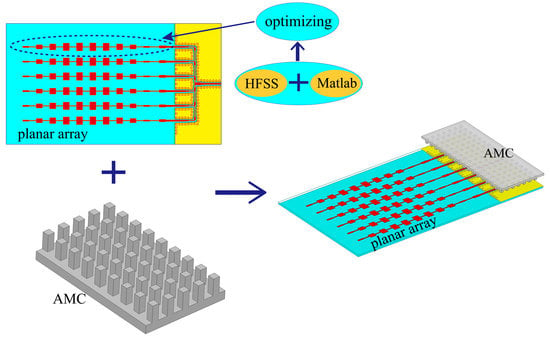Low Sidelobe Series-Fed Patch Planar Array with AMC Structure to Suppress Parasitic Radiation
Abstract
:1. Introduction
- The reported methods for achieving the low SLL of a series-fed array cannot take into account the reflection coefficient. In this work, we built a Matlab-HFSS joint optimizing platform to easily optimize the SLL and S11 of the series-fed patch array.
- Aimed at the problem of parasitic radiation from a microstrip-based feeding network, we propose an efficient method of loading an artificial magnetic conductor (AMC) to solve this problem. A bed-of-nails structure is used as an AMC and is arranged above the feeding network to suppress the unwanted radiation, which enables the radiation performance of the linear array to be unaffected. The proposed method has the advantage of a simple design and low cost. Meanwhile, there is no perfect electrical contact between the AMC structure and feeding network, which greatly facilitates assembly and enhances its practicality.
- A prototype of the designed low-SLL microstrip antenna planar array is fabricated and measured for verification. The SLLs of −24 dB and −23 dB in the E- and H-planes at 79 GHz are realized, respectively. The measured results verify the correctness of the design.
2. Planar Array Design
2.1. The Design of a Low-SLL, Series-Fed Patch Antenna Sub-Array
2.2. The Design of the Feeding Network
2.3. The Design and Analysis of AMC Structure
2.4. The Design and Analysis of the Proposed Low-SLL Planar Array
3. Results and Discussion
4. Conclusions
Author Contributions
Funding
Data Availability Statement
Acknowledgments
Conflicts of Interest
References
- Ku, B.H.; Schmalenberg, P.; Inac, O.; Gurbuz, O.D.; Lee, J.S.; Shiozaki, K.J.; Rebeiz, G.M. A 77–81-GHz 16-Element Phased-Array Receiver With ±50° Beam Scanning for Advance Automotive Radars. IEEE Trans. Microw. Theory Tech. 2014, 62, 2823–2832. [Google Scholar] [CrossRef]
- Ahmad, W.A.; Kucharski, M.; Ergintav, A.; Ng, H.J.; Kissinger, D.A. Planar Differential Wide Fan-Beam Antenna Array Architecture: Modular high-gain array for 79-GHz multiple-input, multiple-output radar applications. IEEE Antennas Propag. Mag. 2021, 63, 21–23. [Google Scholar] [CrossRef]
- Engels, F.; Heidenreich, P.; Zoubir, A.M.; Jondral, F.K.; Wintermantel, M. Advances in Automotive Radar: A framework on computationally efficient high-resolution frequency estimation. IEEE Signal Process. Mag. 2017, 34, 36–46. [Google Scholar] [CrossRef]
- Menzel, M.; Moebius, A. Antenna Concepts for Millimeter-Wave Automotive Radar Sensors. Proc. IEEE 2012, 100, 2372–2379. [Google Scholar] [CrossRef]
- Hasch, J.; Topak, E.; Schnabel, R.; Zwick, T.; Weigel, R.; Waldschmidt, C. Millimeter-Wave Technology for Automotive Radar Sensors in the 77 GHz Frequency Band. IEEE Trans. Microw. Theory Tech. 2012, 60, 845–860. [Google Scholar] [CrossRef]
- Harter, M.; Hildebrandt, J.; Ziroff, A.; Zwick, T. Self-Calibration of a 3-D-Digital Beamforming Radar System for Automotive Applications with Installation Behind Automotive Covers. IEEE Trans. Microw. Theory Tech. 2016, 64, 2994–3000. [Google Scholar] [CrossRef]
- Pimentel, J.R. Data heterogeneity, characterization, and integration in the context of autonomous vehicles. In Proceedings of the IECON 2017—43rd Annual Conference of the IEEE Industrial Electronics Society, Beijing, China, 29 October–1 November 2017; pp. 4571–4576. [Google Scholar]
- Yin, J.; Wu, Q.; Yu, C.; Wang, H.; Hong, W. Low-Sidelobe-Level Series-Fed Microstrip Antenna Array of Unequal Interelement Spacing. IEEE Antennas Wirel. Propag. Lett. 2017, 16, 1695–1698. [Google Scholar] [CrossRef]
- Kang, Y.; Noh, E.; Kim, K. Design of Traveling-Wave Series-Fed Microstrip Array with a Low Sidelobe Level. IEEE Antennas Wirel. Propag. Lett. 2020, 19, 1395–1399. [Google Scholar] [CrossRef]
- Chopra, R.; Kumar, G. Series-Fed Binomial Microstrip Arrays for Extremely Low Sidelobe Level. IEEE Trans. Antennas Propag. 2019, 67, 4275–4279. [Google Scholar] [CrossRef]
- Khalili, H.; Mohammadpour-Aghdam, K.; Alamdar, S.; Mohammad-Taheri, M. Low-Cost Series-Fed Microstrip Antenna Arrays with Extremely Low Sidelobe Levels. IEEE Trans. Antennas Propag. 2018, 66, 4606–4612. [Google Scholar] [CrossRef]
- Arnieri, A.; Greco, F.; Boccia, L.; Amendola, G. A Reduced Size Planar Grid Array Antenna for Automotive Radar Sensors. IEEE Antennas Wirel. Propag. Lett. 2018, 17, 2389–2393. [Google Scholar] [CrossRef]
- Alsath, M.G.N.; Lawrance, L.; Kanagasabai, M. Bandwidth-Enhanced Grid Array Antenna for UWB Automotive Radar Sensors. IEEE Trans. Antennas Propag. 2015, 63, 5215–5219. [Google Scholar] [CrossRef]
- Khan, O.; Meyer, J.; Baur, K.; Waldschmidt, C. Hybrid Thin Film Antenna for Automotive Radar at 79 GHz. IEEE Trans. Antennas Propag. 2017, 65, 5076–5085. [Google Scholar] [CrossRef]
- Zhang, L.; Zhang, W.; Zhang, Y.P. Microstrip Grid and Comb Array Antennas. IEEE Trans. Antennas Propag. 2011, 59, 4077–4084. [Google Scholar] [CrossRef]
- Mosalanejad, M.; Ocket, I.; Soens, C.; Vandenbosch, G.A.E. Multilayer Compact Grid Antenna Array for 79 GHz Automotive Radar Applications. IEEE Antennas Wirel. Propag. Lett. 2018, 17, 1677–1681. [Google Scholar] [CrossRef]
- Mosalanejad, M.; Ocket, I.; Soens, C.; Vandenbosch, G.A.E. Wideband Compact Comb-Line Antenna Array for 79 GHz Automotive Radar Applications. IEEE Antennas Wirel. Propag. Lett. 2018, 17, 1580–1583. [Google Scholar] [CrossRef]
- Yoo, S.; Milyakh, Y.; Kim, H.; Hong, C.; Choo, H. Patch Array Antenna Using a Dual Coupled Feeding Structure for 79 GHz Automotive Radar Applications. IEEE Antennas Wirel. Propag. Lett. 2020, 19, 676–679. [Google Scholar] [CrossRef]
- Yu, C.A.; Jin, H.Y.; Cao, Y.; Su, G.R.; Che, W.Q.; Chin, K.S. 24 GHz Horizontally Polarized Automotive Antenna Arrays With Wide Fan Beam and High Gain. IEEE Trans. Antennas Propag. 2019, 67, 892–904. [Google Scholar] [CrossRef]
- Yang, X.Y.; Liu, X.F. Design of a Wide-Beam Microstrip Array Antenna for Automotive Radar Application. IEEE Access 2021, 9, 142340–142347. [Google Scholar] [CrossRef]
- Xu, J.; Hong, W.; Zhang, H.; Wang, G.L.; Yu, Y.R.; Jiang, Z.H. An Array Antenna for Both Long- and Medium-Range 77 GHz Automotive Radar Applications. IEEE Trans. Antennas Propag. 2017, 65, 7207–7216. [Google Scholar] [CrossRef]
- Xu, J.F.; Chen, Z.N.; Qing, X.M. CPW Center-Fed Single-Layer SIW Slot Antenna Array for Automotive Radars. IEEE Trans. Antennas Propag. 2014, 62, 4528–4536. [Google Scholar] [CrossRef]
- Shin, D.H.; Kim, K.B.; Kim, J.G.; Park, S.O. Design of Null-Filling Antenna for Automotive Radar Using the Genetic Algorithm. IEEE Antennas Wirel. Propag. Lett. 2014, 13, 738–741. [Google Scholar] [CrossRef]
- Chen, R.S.; Zhu, L.; Wong, S.W.; Yu, X.Z.; Li, Y.; Zhang, L.; He, Y.J. Low-Sidelobe Cavity-Backed Slot Antenna Array With Simplified Feeding Structure for Vehicular Communications. IEEE Trans. Veh. Technol. 2021, 70, 3652–3660. [Google Scholar] [CrossRef]
- Qin, L.T.; Lu, Y.L.; You, Q.C.; Wang, Y.; Huang, J.F.; Gardner, P. Millimeter-Wave Slotted Waveguide Array With Unequal Beamwidths and Low Sidelobe Levels for Vehicle Radars and Communications. IEEE Trans. Veh. Technol. 2018, 70, 10574–10582. [Google Scholar] [CrossRef]
- Yu, Y.R.; Hong, W.; Zhang, H.; Xu, J.; Jiang, Z.H. Optimization and Implementation of SIW Slot Array for Both Medium- and Long-Range 77 GHz Automotive Radar Application. IEEE Trans. Antennas Propag. 2018, 66, 3769–3774. [Google Scholar] [CrossRef]
- Tan, Q.Q.; Chen, K.; Fan, K.K.; Luo, G.Q. A Low-sidelobe Series-fed Microstrip Patch Antenna Array for 77 GHz Automotive Radar Applications. In Proceedings of the 2020 Cross Strait Radio Science & Wireless Technology Conference (CSRSWTC), Fuzhou, China, 3–16 December 2020; pp. 1–3. [Google Scholar]
- Sievenpiper, D.; Zhang, L.J.; Broas, R.F.J.; Alexopolous, N.G.; Yablonovitch, E. High-impedance electromagnetic surfaces with a forbidden frequency band. IEEE Trans. Microw. Theory Tech. 1999, 47, 2059–2074. [Google Scholar] [CrossRef] [Green Version]
- Kildal, P.S. Artificially soft and hard surfaces in electromagnetics. IEEE Trans. Antennas Propag. 1990, 38, 1537–1544. [Google Scholar] [CrossRef]
- Valero-Nogueira, A.; Alfonso, E.; Herranz, J.I.; Baquero, M. Planar slot-array antenna fed by an oversized quasi-TEM waveguide. Microw. Opt. Technol. Lett. 2007, 49, 1875–1877. [Google Scholar] [CrossRef]
- Alfonso, E.; Kildal, P.S.; Valero, A.; Herranz, J.H. Study of local quasi-TEM wave in oversize waveguide with one hard wall for killing higher order global modes. In Proceedings of the 2008 IEEE Antennas and Propagation Society International Symposium, San Diego, CA, USA, 5–11 July 2008; pp. 1–4. [Google Scholar]
- Padilla de la Torre, P.; Fernández, J.M.; Sierra-Castañer, M. Characterization of artificial magnetic conductor strips for parallel plate planar antennas. Microw. Opt. Technol. Lett. 2008, 50, 498–504. [Google Scholar] [CrossRef] [Green Version]
- Kildal, P.S.; Alfonso, E.; Valero-Nogueira, A.; Raji-Iglesias, E. Local metamaterial-based waveguides in gaps between parallel metal plates. IEEE Antennas Wirel. Propag. Lett. 2009, 8, 84–87. [Google Scholar] [CrossRef]
- Alfonso, E.; Kildal, P.S.P.; Valero-Nogueira, A.; Herranz, J.I. Numerical analysis of a metamaterial-based ridge gap waveguide with a bed of nails as parallel-plate mode killer. In Proceedings of the 2009 3rd European Conference on Antennas and Propagation, Berlin, Germany, 23–27 March 2009; pp. 23–27. [Google Scholar]
- Liu, J.L.; Yang, J.; Zaman, A.U. Analytical Solutions to Characteristic Impedance and Losses of Inverted Microstrip Gap Waveguide Based on Variational Method. IEEE Trans. Antennas Propag. 2018, 66, 7049–7057. [Google Scholar] [CrossRef] [Green Version]
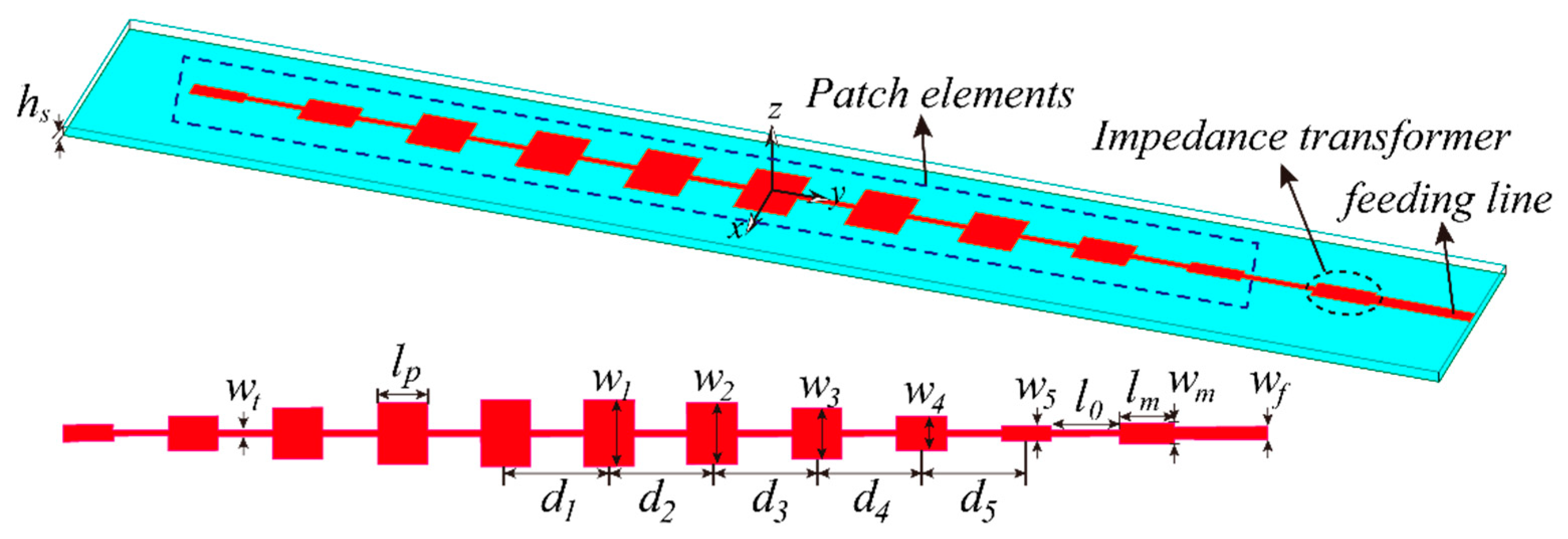


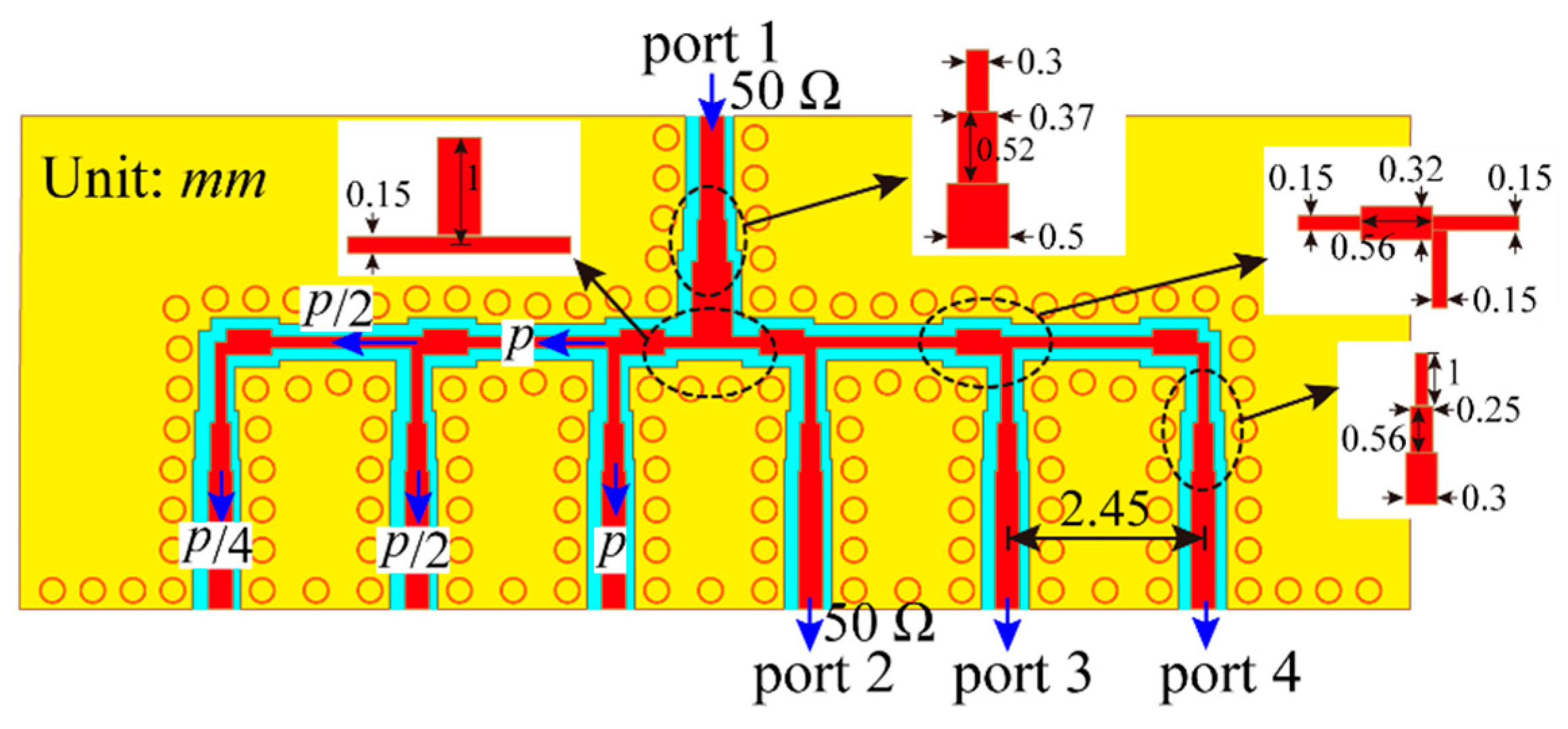
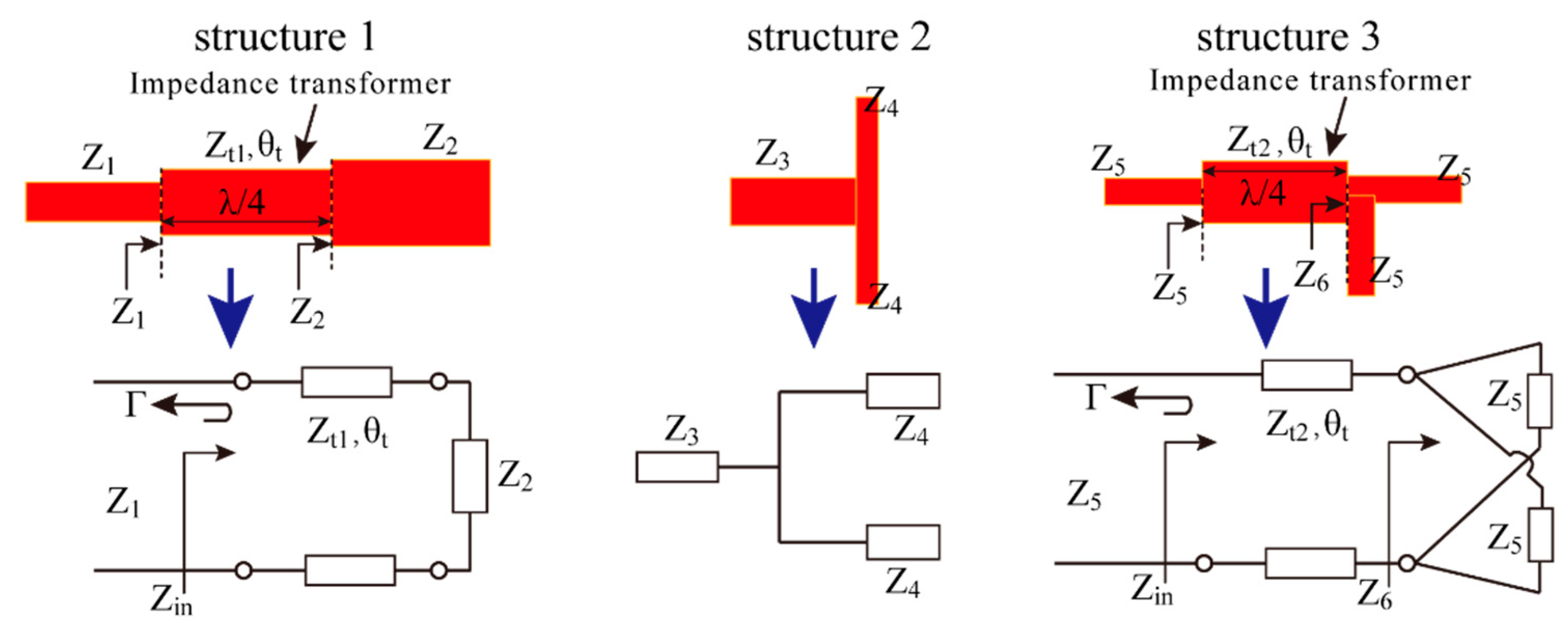

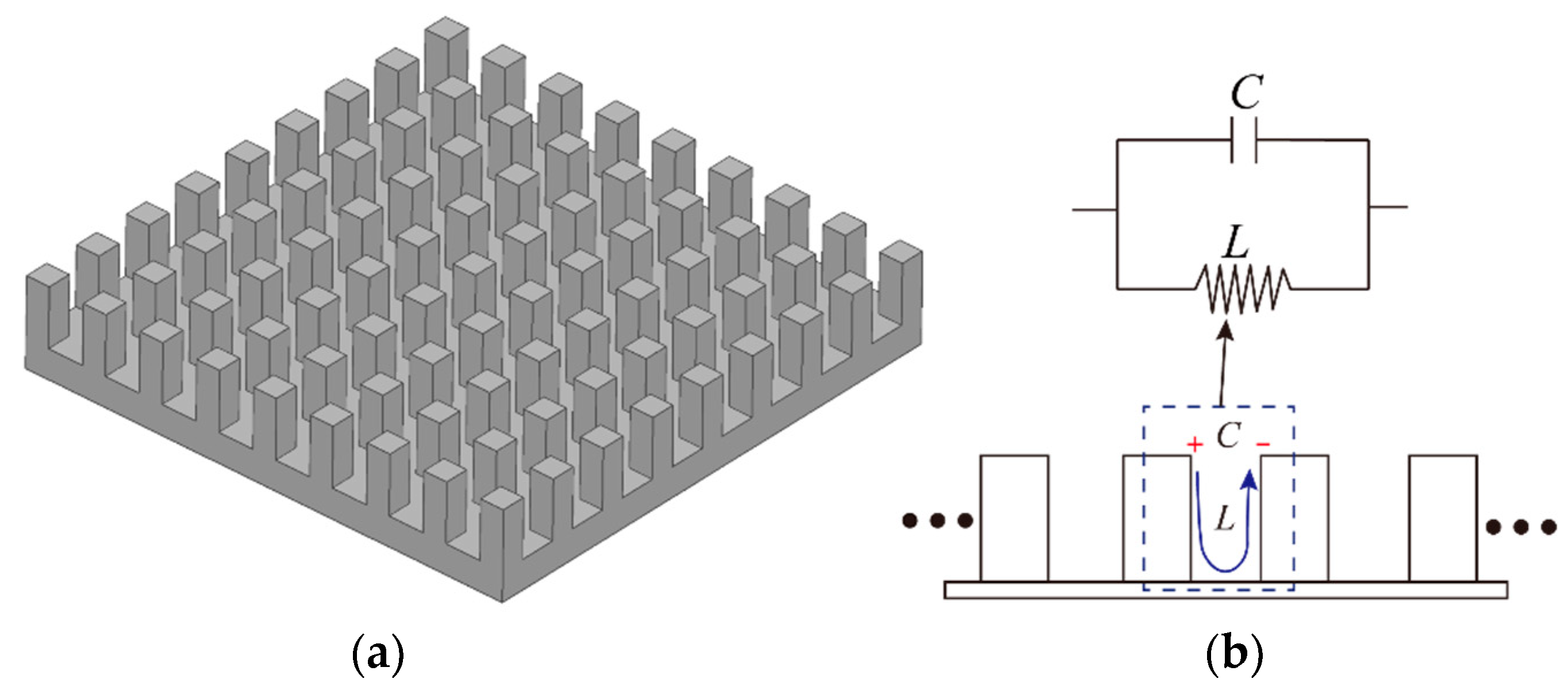
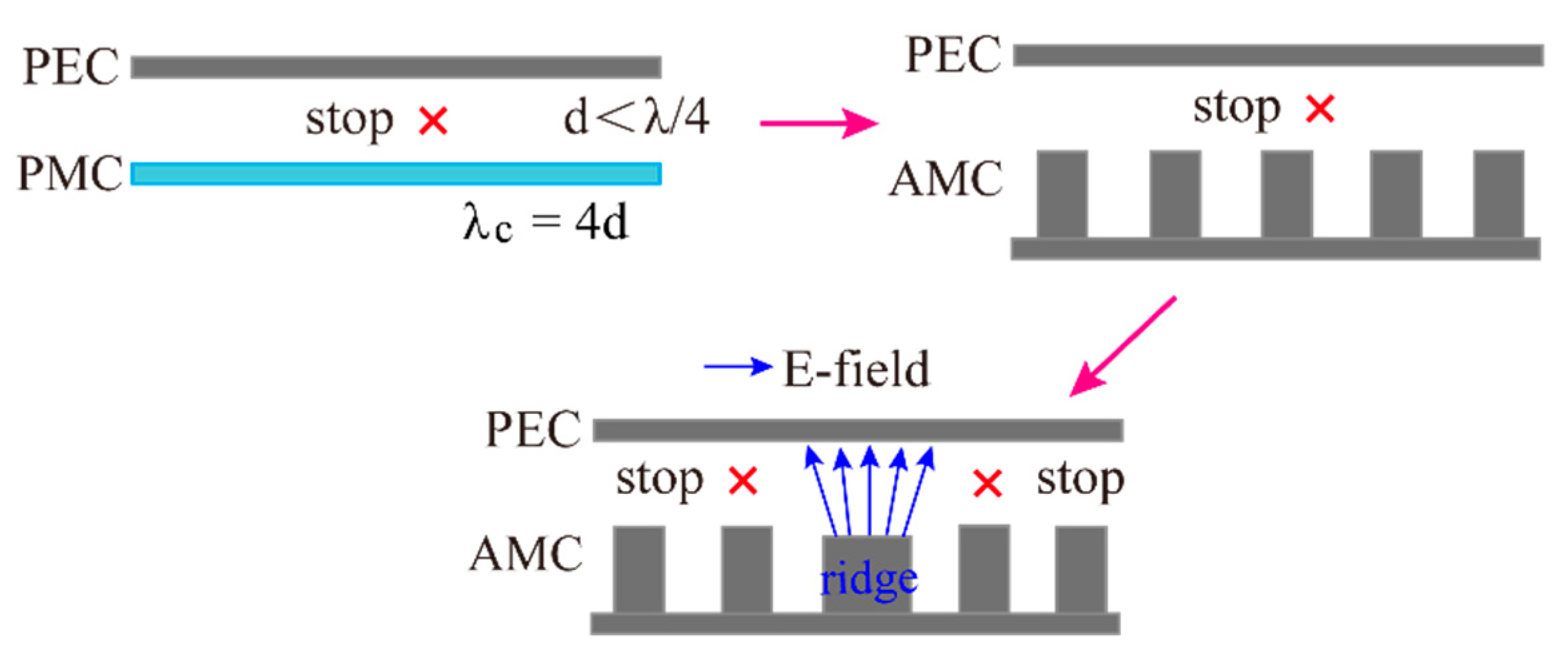
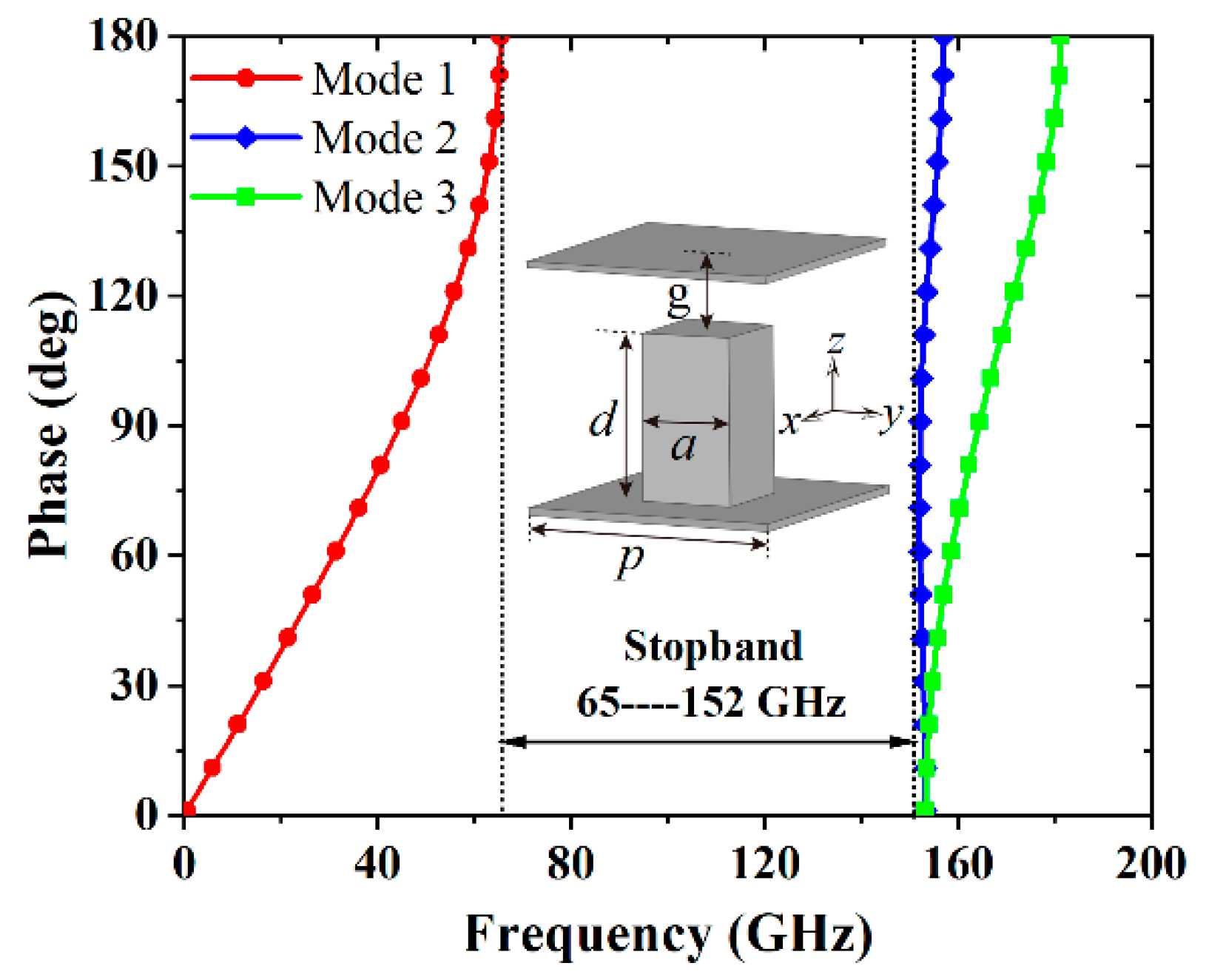

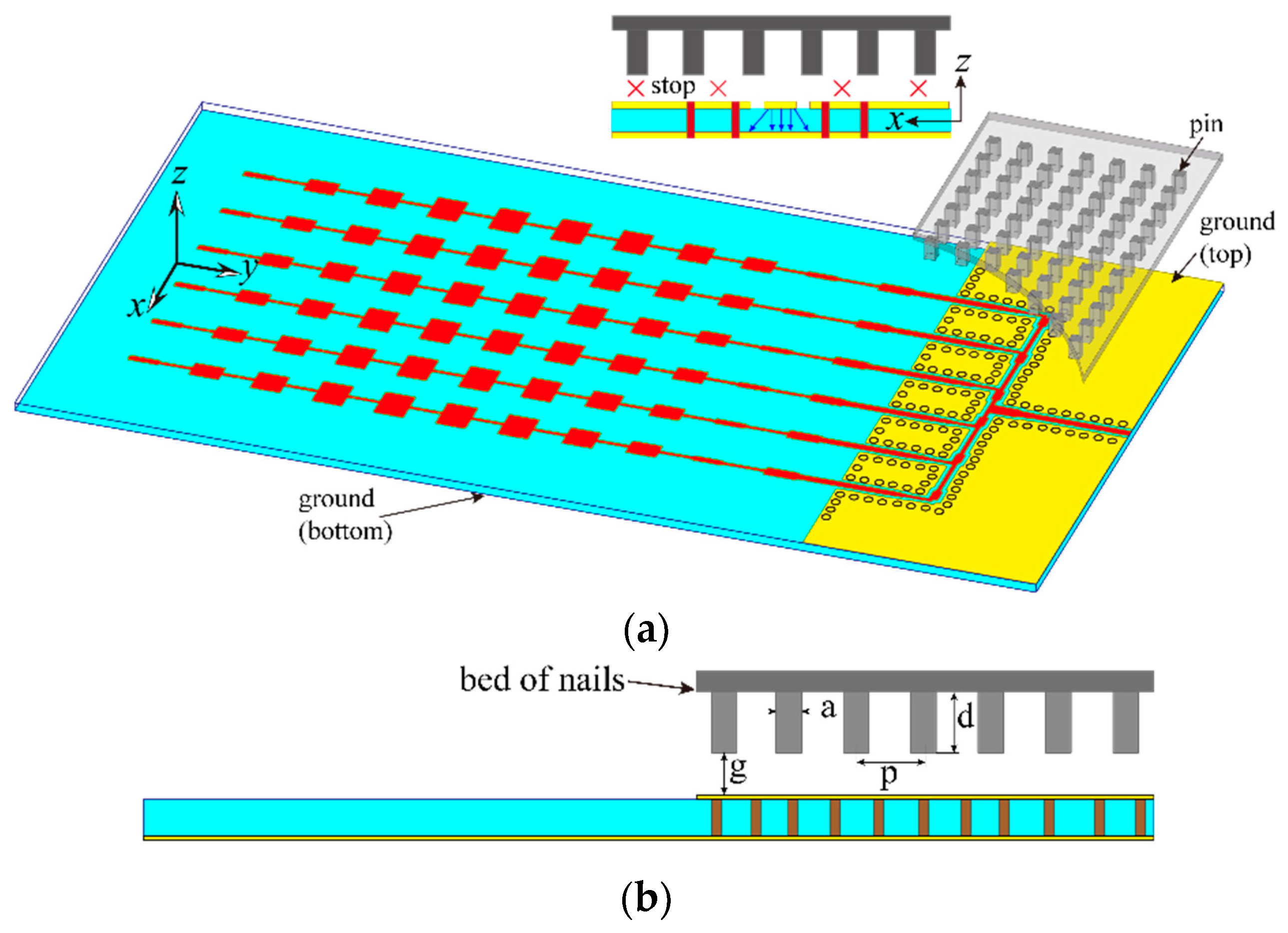

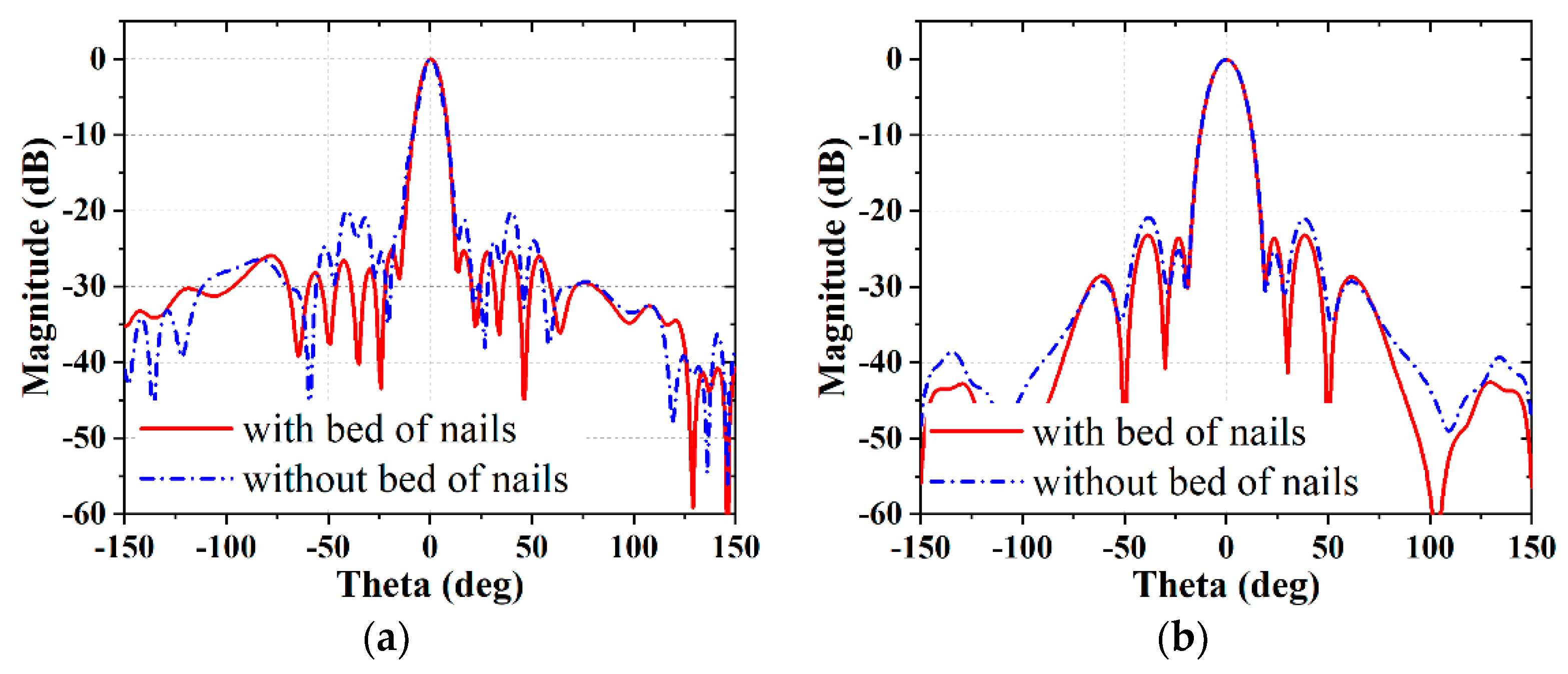
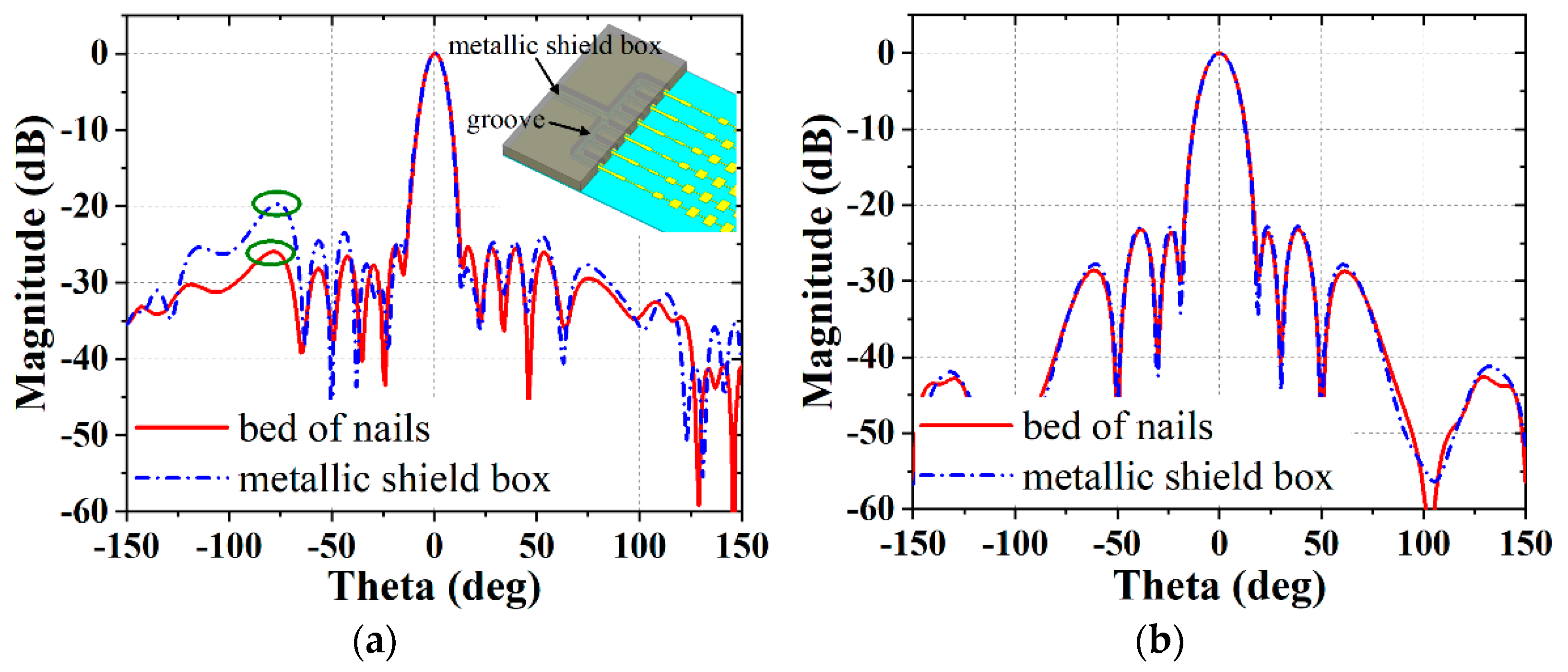
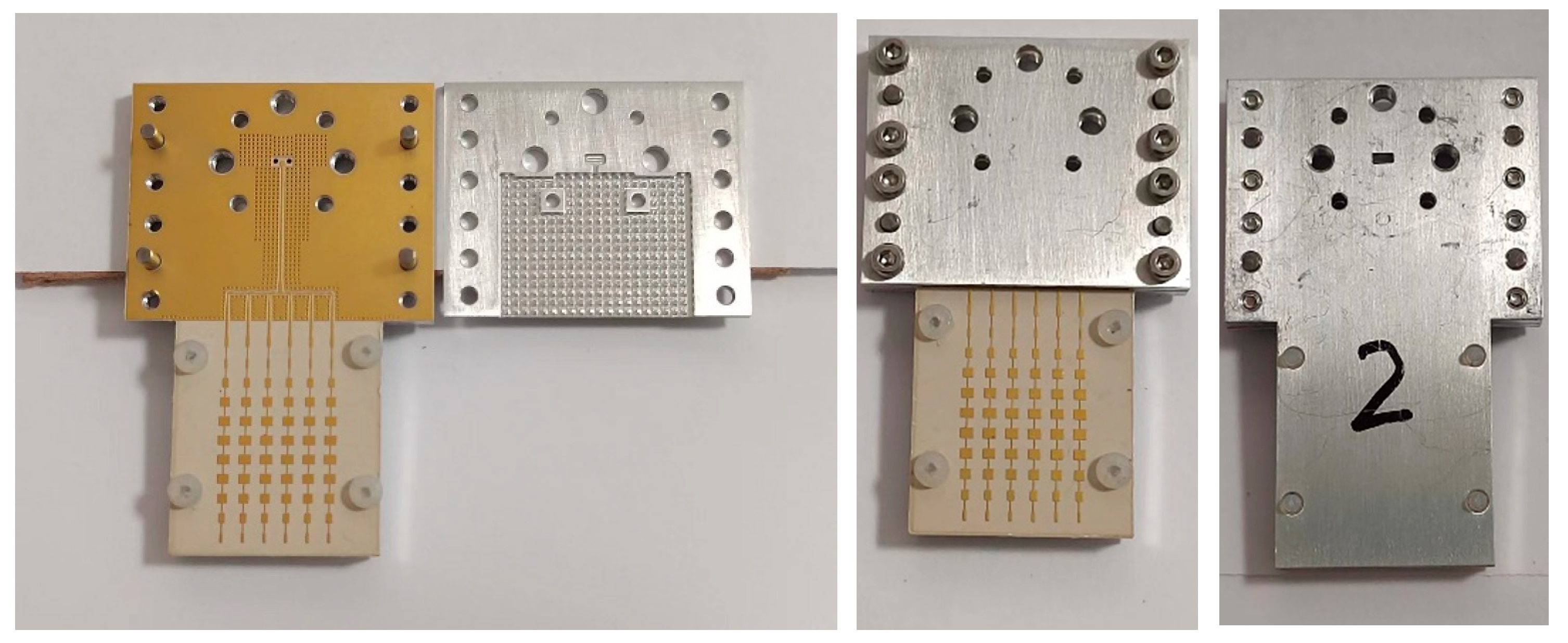
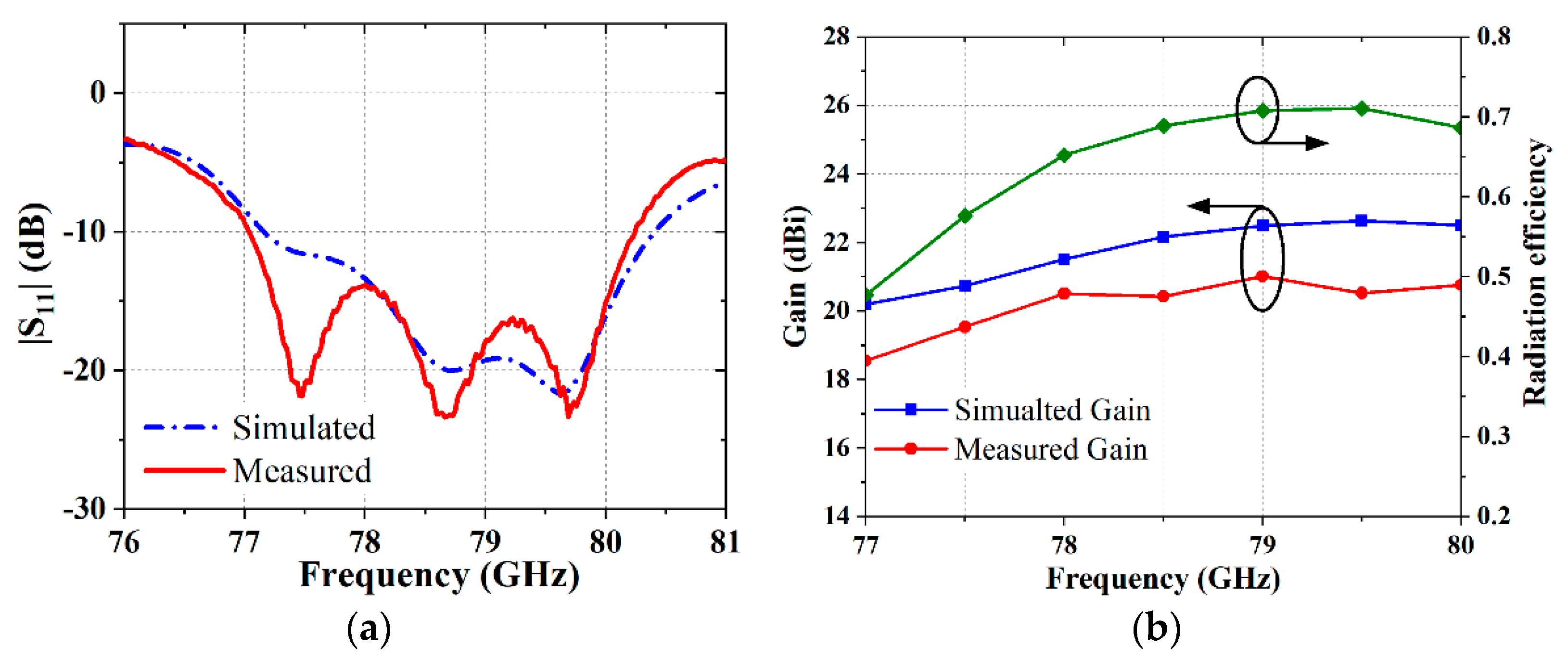
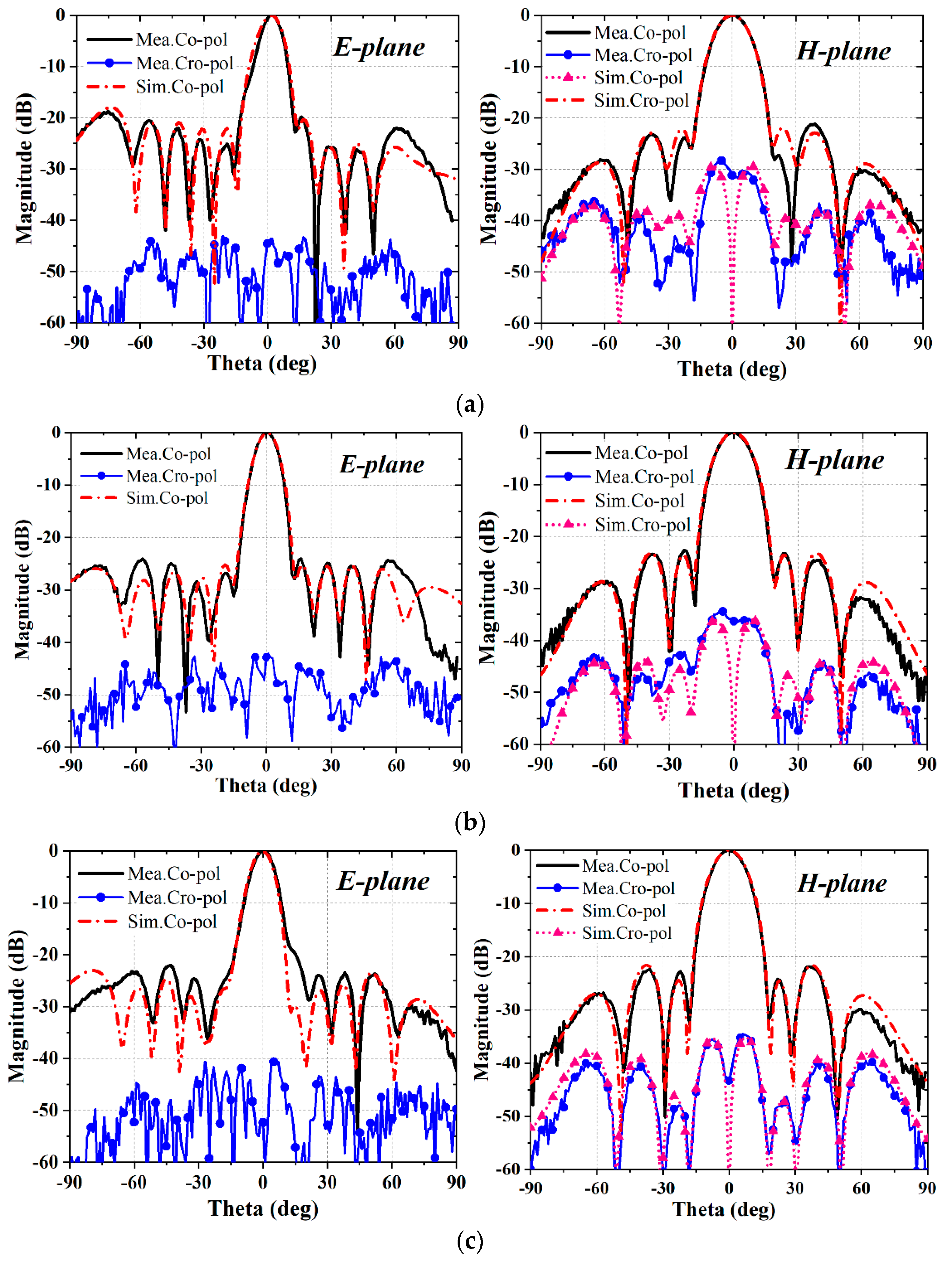
| w1 | w2 | w3 | w4 | w5 | wm | wf | d1 |
|---|---|---|---|---|---|---|---|
| 0.32 | 0.72 | 1.08 | 1.3 | 1.41 | 0.44 | 0.3 | 2.19 |
| d2 | d3 | d4 | d5 | lp | l0 | lm | wt |
| 2.19 | 2.23 | 2.22 | 2.23 | 1.06 | 1.49 | 1.15 | 0.12 |
Publisher’s Note: MDPI stays neutral with regard to jurisdictional claims in published maps and institutional affiliations. |
© 2022 by the authors. Licensee MDPI, Basel, Switzerland. This article is an open access article distributed under the terms and conditions of the Creative Commons Attribution (CC BY) license (https://creativecommons.org/licenses/by/4.0/).
Share and Cite
Tan, Q.; Fan, K.; Yang, W.; Luo, G. Low Sidelobe Series-Fed Patch Planar Array with AMC Structure to Suppress Parasitic Radiation. Remote Sens. 2022, 14, 3597. https://doi.org/10.3390/rs14153597
Tan Q, Fan K, Yang W, Luo G. Low Sidelobe Series-Fed Patch Planar Array with AMC Structure to Suppress Parasitic Radiation. Remote Sensing. 2022; 14(15):3597. https://doi.org/10.3390/rs14153597
Chicago/Turabian StyleTan, Qingquan, Kuikui Fan, Wenwen Yang, and Guoqing Luo. 2022. "Low Sidelobe Series-Fed Patch Planar Array with AMC Structure to Suppress Parasitic Radiation" Remote Sensing 14, no. 15: 3597. https://doi.org/10.3390/rs14153597
APA StyleTan, Q., Fan, K., Yang, W., & Luo, G. (2022). Low Sidelobe Series-Fed Patch Planar Array with AMC Structure to Suppress Parasitic Radiation. Remote Sensing, 14(15), 3597. https://doi.org/10.3390/rs14153597







